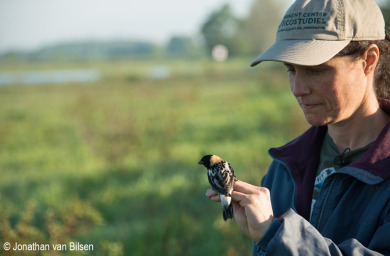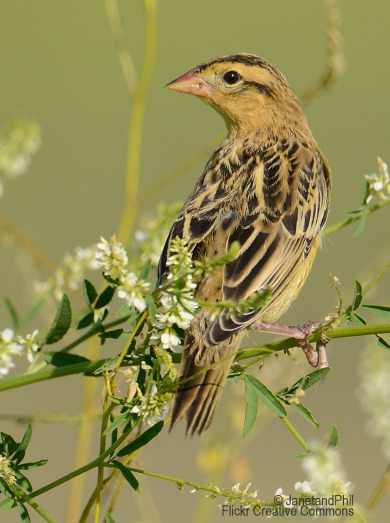Inspiring poetry from the likes of Emily Dickinson, William Cullen Bryant, and James Russell Lowell, the Bobolink has been revered for deeper life lessons. In modern times, the Bobolink serves as an iconic species of North American grasslands, a poster child for the plight and conservation of grassland birds.
Sadly, this seed-eating bird has been viewed as a plague by rice farmers in North and South America – at both ends of its hemispheric range. VCE is leading international work on the conservation of this classic grassland species.
 About half of the entire Bobolink population has been lost since 1970, and declines continue today. Restoring and maintaining quality grassland habitat in North America is central to conserving populations of Bobolinks by ensuring there is adequate breeding habitat.
About half of the entire Bobolink population has been lost since 1970, and declines continue today. Restoring and maintaining quality grassland habitat in North America is central to conserving populations of Bobolinks by ensuring there is adequate breeding habitat.
But what happens to Bobolinks for eight months of the year after they leave their breeding grounds? Avian ecologists and conservationists agree that to conserve a migratory species, we need to know about the entire life of a bird.
“Full life cycle” conservation means that we address the needs of birds throughout the year, acknowledging that what happens during the nonbreeding season can impact the breeding season and vice versa. We must identify the threats to bird populations during the nonbreeding season as well as the breeding season, and determine whether those threats significantly hinder survival and even reproduction.
VCE has been filling in what was once a gaping hole in our understanding of the life of Bobolinks. Sometimes we track down Bobolinks in South America, sometimes we use remote methods to figure out what they’re up to. Over the last decade we discovered enormous roosts on its wintering grounds, documented the species’ reliance on rice in winter, and its exposure to harmful pesticides in rice-growing regions. Using geolocators, we have described its range-wide migration patterns, important migratory stops, and wintering grounds.
Cool Bobolink Facts
- In Bolivian rice farms, Bobolinks are a pest species that are controlled with scare tactics. The species is known as “pin-pin,” a mimic of its winter call. Shooters that are sent out to scare the birds are sometimes called “pin-piñeros.”
- Bobolinks seem to have a preference for certain varieties of rice over others. The structure of the plant may be important, as the birds may select varieties that easily allow them to perch on the top of the plant and access the rice. In Bolivia, they appear to prefer the sweeter, more expensive varieties that humans also find tastiest.
- Although Bobolinks are primarily seed eaters during the nonbreeding season, we have seen them systematically working their way through soy fields in Bolivia, eating nothing but pest caterpillars. In these cases, they can be a beneficial rather than pests to farmers.
Conservation Action
 In partnership with the US Fish and Wildlife Service and several academic institutions, agencies, and non-profit organizations, VCE led the development of a full life cycle Bobolink Conservation Plan that will address the needs of several grassland species. We are forging partnerships with South American organizations to coordinate conservation efforts between breeding, migration, and wintering grounds.
In partnership with the US Fish and Wildlife Service and several academic institutions, agencies, and non-profit organizations, VCE led the development of a full life cycle Bobolink Conservation Plan that will address the needs of several grassland species. We are forging partnerships with South American organizations to coordinate conservation efforts between breeding, migration, and wintering grounds.
Most grasslands are privately owned, and Bobolink conservation will require that landowners have the incentives and information to manage their lands in a way that will provide the right habitat. To have an immediate impact, we are engaged with local on-the-ground conservation through outreach to private landowners. In Vermont and New Hampshire, we are providing willing landowners with the information they need to provide quality habitat for Bobolinks and other grassland birds.
Publications
-
Renfrew, R. B., J. M. Hill, D. H. Kim, C. Romanek, and N. G. Perlut. 2017. Winter diet of Bobolink, a long-distance migratory grassland bird, inferred from feather isotopes. Condor 119:439-448. doi: 10.1650/CONDOR-16-162.1
- Perlut, N. P. and R. Renfrew. 2017. Stopover on Galapagos During Autumn Migration of Bobolinks (Dolichonyx oryzivorus). Wilson Journal of Ornithology 128:935-938. DOI: 10.1676/15-195.1
- Levin, I. I., R. E. Colborn, D. Kim, N. G. Perlut, R. B. Renfrew and P. G. Parker. 2016. Local parasite lineage sharing in temperate grassland birds provides clues about potential origins of Galapagos avian Plasmodium. Ecology and Evolution. DOI: 10.1002/ece3.1894
- Levin, I.I., P. Zwiers, S. L. Deem, E. A. Geest, J. M. Higashiguchi, T. A. Iezhova, G. Jim´enez-ucz´ategui, D. H. Kim, J. P. Morton, N. G. Perlut, R. B. Renfrew, E. H. R. Sari, G. Valkiunas, and P. G. Parker. 2013. Multiple lineages of avian malaria parasites (Plasmodium) in the Galapagos Islands and evidence for arrival via migratory birds. Conservation Biology. DOI: 10.1111/cobi.12127 (Abstract)
- Renfrew, R. B., D. Kim, N. Perlut, J. Fox, J. Smith, and P. P. Marra. 2013. Phenological matching across hemispheres in a long-distance migratory bird. Diversity and Distributions 19:1008–1019. (Abstract)
- Renfrew, R., S. J. K. Frey, and J. Klavins. 2011. Phenology and sequence of the complete prealternate molt of Bobolinks in South America. Journal of Field Ornithology 82:101-113. (Abstract)
- Parsons, K. C., P. Mineau, and R. B. Renfrew. 2010. Effects of pesticide use in rice fields on birds. Waterbirds 33 (SP1):193-218. (Abstract)
- Renfrew, R.B. and A.M. Saavedra 2007. Ecology and conservation of Bobolinks in rice production regions of Bolivia. Ornitologia Neotropical 18:61-73. (Abstract)
- Renfrew, R.B. 2007. An interspecific foraging association between Nearctic-Neotropical Migrant Passerines in Bolivia. Wilson Journal of Ornithology 119:124-126. (Abstract)

